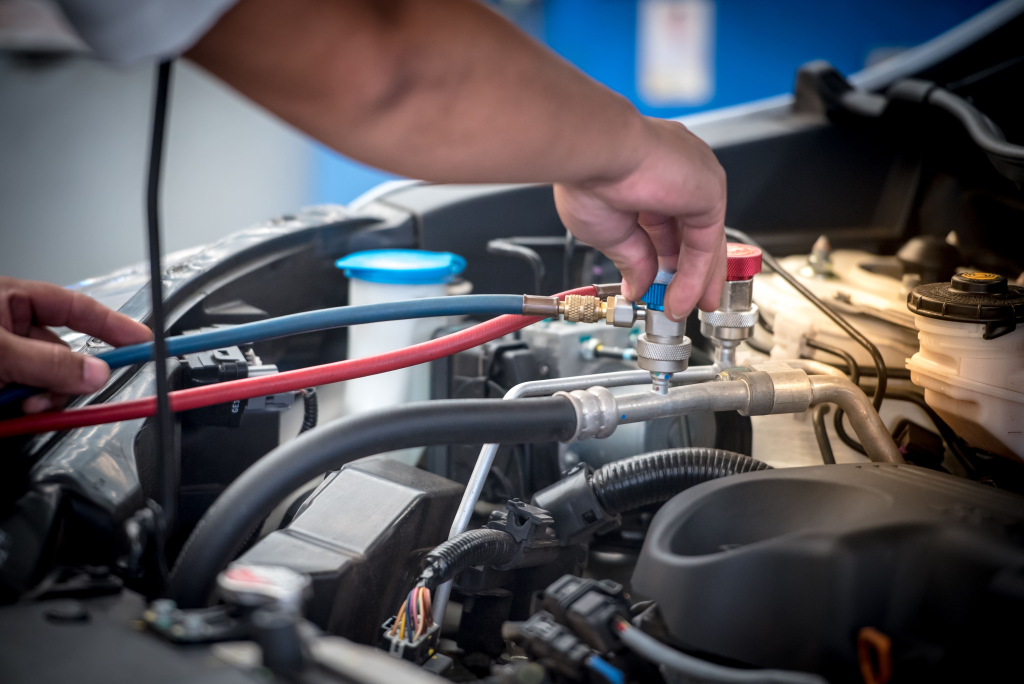There’s nothing more frustrating than hopping into your car on a hot day, turning on the AC, and feeling. Warm air. Even worse? When you’ve refilled the gas, your car AC still refuses to cool. If you’re in this situation, don’t worry — you’re not alone. Most drivers have this problem, typically indicating issues beyond refrigerant levels. Let’s discuss why your car AC is not cooling despite a gas refill, what might be the cause, and how to resolve it.
Introduction: Why This Happens More Often Than You Think
Your car’s air conditioning system is a complex operation involving several components in harmony — refrigerant (also called AC gas) is only one. Therefore, despite a Car AC Gas service sounding like the complete solution, it’s only a single piece of the puzzle. If your AC isn’t cooling even after a refill, something is probably awry — and neglecting it could result in greater (and more costly) issues later.

1. Gas Leak within the AC System
Let’s begin with the most frequent suspect: a gas leak. If your AC was running low on refrigerant before the refill, and it still won’t cool, then there’s likely a leak in the system. Rubber hoses, O-rings, or seals in your AC system can wear out over time, leading to refrigerant loss.
Indications of a Leak:
- Hissing noise from the AC
- Weakened airflow
- Cooling that rapidly dissipates after the gas refill
A proper Car AC Gas service should include a leak test using UV dye or a pressure test. If a leak is found, it should be repaired before more gas is added — otherwise, you’re just wasting money.
2. Compressor Failure
The compressor is the central piece of your vehicle’s AC system. It compresses the refrigerant and drives it through the system. If it fails, the AC will not cool appropriately — regardless of how much gas it contains.
The most likely reasons for compressor failure:
- Electrical problems
- Internal mechanical failure
- Low refrigerant causing lubrication failure (before refill)
A bad compressor typically must be replaced, and it can be one of the costlier repairs. But it’s a requirement for your system to operate correctly.
3. Blocked or Clogged Condenser
The Condenser dissipates heat from the refrigerant. The system cannot cool the air properly if it’s internally clogged or blocked (by dirt or debris).
Indications of a Condenser Issue:
- Overheating engine when AC is operating
- Warm air blowing even after gas refill.
- Unusual sounds coming from the front of the vehicle
A good cleaning at times will correct this. Otherwise, the Condenser may need to be replaced, particularly if the blockage is internal.
4. Malfunctioning Cooling Fans
The cooling fans assist in lowering the temperature of the refrigerant by blowing air across the Condenser. Your AC will not be able to cool the refrigerant effectively if these fans are broken, damaged, or do not have power — causing hot air to blow through your vents.
What to Check:
- Are the fans running when the AC is operating?
- Is there a blown fuse or a bad relay?
Replacing a malfunctioning fan is usually a minor fix but essential for an operating AC system.
5. Stuck or faulty Expansion Valve or Orifice Tube
This unit controls the amount of refrigerant entering the evaporator. If stuck or faulty, it can result in too much or too little refrigerant flowing into the evaporator, which can play havoc with cooling performance.
Symptoms:
- Erratic cooling
- Frost forming on AC lines.
- Gauges show high-pressure readings.
Replacing a defective expansion valve is a specific repair that can bring about standard cooling if this is the cause of the problem.
6. Electrical Faults or Blown Fuses
Occasionally, the problem isn’t mechanical but electrical. A blown fuse, bad relay, or compromised wiring may keep critical items such as the compressor or fans from functioning.
Items to Check:
- AC fuses
- Relays
- AC control module
A correct diagnostic scan will identify whether the issue is electrical or mechanical.
7. Incorrect AC Gas Refill
All gas refills are not the same. Too much refrigerant or an incorrect type of refrigerant can be as much trouble as low charge.
Indications of Overcharge:
- The pressure relief valve
- Warming air through the vents
- Shutting off the compressor frequently
Always have your AC Gas serviced by a professional who uses the correct specifications for your vehicle.

Conclusion: Don’t Just Refill — Diagnose
If your car AC isn’t cooling even after a gas refill, it indicates something more profound is amiss. Topping off the refrigerant will not rectify the issue, be it a leak, faulty compressor, clogged Condenser, or electrical fault. A professional diagnosis must identify the actual cause and repair it accordingly.
Search for a workshop that provides a full Car AC service, including leak checks, pressure tests, and complete system diagnosis. It might take a bit extra work initially, but it’ll keep you from going back and forth to the mechanic — and save you getting that lovely, chilled blast of air on a hot day.
So, don’t immediately grab the gas refill the next time your AC malfunctions. Ask the bigger question: “What else could be wrong?”



